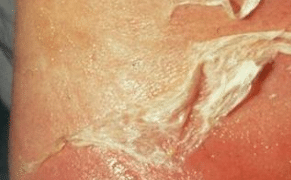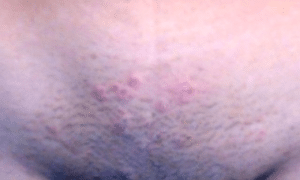A look at the small white spots on skin, patches, small, itchy, pictures, on the legs, face, body, bumps, from tanning and how to get rid of them.
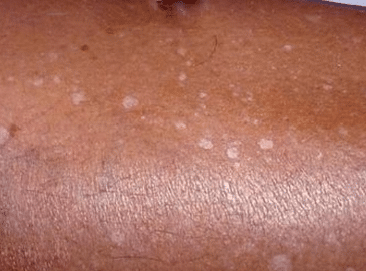
small white spots on skin
Small White Spots on Skin
The main indication of vitiligo is flat, white spots or even patches on the skin. The first white patch normally develops where the skin has been exposed to the sun.
Initially, the vitiligo can begin as a patch of skin that is more pale than the rest. Slowly, the patch will be completely white. The center of the patch can sometimes be white, with pale skin around it. In the areas where there are several blood vessels underneath the skin, the patch can be slightly pink, rather than being white.
The edges of the patch can also be smooth or even irregular. The edges are at times inflamed or there is hyperpigmentation (brownish discoloration of the skin).
Vitiligo does not lead to discomfort to the skin, like the dryness, but small white spots on skin can occasionally be itchy.
If you have vitiligo, the pale areas of the skin are much vulnerable to sunburn.
The areas that are most commonly affected by vitiligo are:
- the skin around your mouth and eyes
- fingers and wrists
- armpits
- genitals
Vitiligo may sometimes develop at the area where there are several hair roots, like the on the scalp. The lack of melanin in the skin may turn the hair in the affected spot to be white or grey.
Types of vitiligo
There are two types of vitiligo:
- non-segmental vitiligo
- segmental vitiligo
In rare the cases, it’s much possible for the vitiligo to affect the whole body. This is called universal or complete vitiligo.
Non-segmental vitiligo
In non-segmental vitiligo (also known as bilateral or generalized vitiligo), the symptoms of the vitiligo normally appear on both sides of the body as symmetrical small white spots on skin. Symmetrical patches may appear on the:
- backs of the hands
- arms
- knees
- feet
Non-segmental vitiligo is the common type of vitiligo, affecting up to 8 out of 10 people with the condition.
Segmental vitiligo
The white patches can sometimes only affect one area of the body. This is called segmental, unilateral or also localized vitiligo.
Segmental vitiligo is not much common than non-segmental vitiligo, although it’s very common in children. Segmental vitiligo normally begins earlier and affects 4 in 10 children who have vitiligo.
If you have vitiligo, it is very difficult to predict whether the condition will be able to spread from the original patch, or how fast it can spread, as it varies from one person to person.
It’s likely that many white patches will appear. For some other people, this can occur quickly. For others, the patches can stay the same for several months or years.
If the white patches occur symmetrically on more than one part of the body, then the condition may progress very slowly, with periods when the patches do not change. If you have white patches on only one part of the body, the condition can progress more rapidly.
White Spots on Skin Pictures
White Patches on Skin
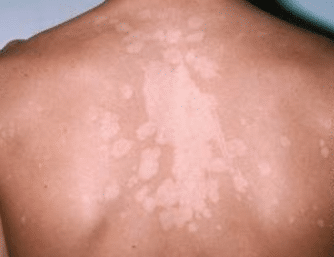
white patches on skin
Skin discoloration is also a common skin problem, and this can come in the form of white spots, dark spots or even other changes in skin color. White spots on that appears on the skin normally indicate a loss of skin pigmentation, and these can happen as small white spots on skin or even large patches that can occur anywhere in the body, including the neck, upper back, and the forearms.
White spots on the skin do not normally lead to pain, itching, or even irritation, but they normally lead to distress, especially in the people who have darker skin, where the contrast in skin color is more obvious.
White spots can happen in people of all races or skin color. They affect both sexes, and are very common in people who live in hot, humid climates. Some of the white spots develop into the brown spots covered by the whitish scaly skin. This type of white spots can be accompanied by itching.
Causes of Small White Spots on Skin
There are several possible causes of white patches, but the most common is vitiligo.
Vitiligo
White patches that develop on most of the areas of one’s skin are normally brought about by vitiligo.
Causes: Vitiligo is a condition that is characterized by the loss of skin pigment known as melanin, which is usually produced by the cells known as melanocytes.
Discoloration is brought about by the destruction of the melanocytes, but the exact cause is not established. One mechanism that has been proposed involves the body’s immune system that destroys its own cells, which is characteristic of the autoimmune disease.
Risk Factors: Around 2-6 million Americans or up to one percent of the US population are mostly affected by vitiligo. The white spots normally appear early, between the first and third decades of life. Men and women are also affected. Risk factors are:
- Family history of vitiligo
- Premature graying of the hair
- Autoimmune diseases
Symptoms: A rapid loss of the skin pigmentation normally indicates the development of vitiligo. However, it can also be followed by a period of stability where the condition do not appear to progress. Cycles of rapid whitish discoloration and also stability can follow.
Small white spots on skin because of vitiligo normally affects the exposed body parts and the skin folds (like the armpit), but can also affect areas of the previous injury, the skin around moles or even the body openings. It can also be observed on the hair and eyelids.
Once the white spots have fully developed, the skin may not return to its original color.
Diagnosis and Treatment: The diagnosis of the skin condition is made by a doctor after taking a medical history and also a physical examination.
But, one can neither prevent nor permanently cure vitiligo. The reason for treatment is to improve the physical appearance of the skin by use of cosmetics to camouflage the white spots, inducing the re-pigmentation by use of corticosteroid treatment or even phototherapy, reducing the pigmentation of unaffected area, and by skin grafting.
Tinea Versicolor
Tinea versicolor or ptyriasis versicolor is also common and harmless skin condition that normally affects skin color.
Causes: It is brought about by yeast known as Malassezia, which usually exist in small numbers on the skin. Some conditions however, can lead to the overgrowth of the yeast, leading to the development of the white and reddish-brown spots on skin.
Moist and oily skin encourages yeast overgrowth more especially in the upper arms, neck, abdomen, and also thighs. It is not a contagious disease.
Risk Factors: Conditions that cause the appearance of white spots on the skin related to tinea versicolor are warm and humid climate, oily skin, malnutrition, medications like corticosteroids, or any factor that can weaken the immune system.
Treatments: Antifungal medications like terbinafine, or miconazole can be used to treat the infection. Shampoo that has selenium sulfide may be used as a lotion on the affected skin before bedtime. This can also be rinsed off in the morning. One should also consult a dermatologist if the symptoms persist after these over-the-counter treatments used for at least two weeks.
Idiopathic Guttate Hypomelanosis
White spots that are the flat and measure about three to five millimeters in diameter are the characteristic of a skin condition called idiopathic guttate hypomelanosis. Although they are normally smooth, they might also become scaly.
They are very common among women and amongst the people who have fair skin, but they may also happen in people who have darker skin tones. They are normally seen on areas of the body that are exposed to the sun like the face, shoulders, and shins.
Causes: Its name indicates that the cause is not clear. But, the appearance of the small white spots on the skin seems to be associated with the natural aging, since they happen in individuals older than 50 years. Hereditary factors can also be involved as this skin problem seems to run in families.
Risk Factors: Women, hereditary factors and also aging are among the risk factors causing the development of the idiopathic guttate hypomelanosis.
Pityriasis Alba
This common skin discoloration that affects children and also adolescents. This condition is normally characterized by the appearance of dry, scaly white patches on a person’s face. These white skin patches are visible during summer due to tanning in the surrounding skin.
In winter, patches can become dry and scaly. Raised small white spots on skin can also appear and later turn pale, becoming very smooth and also flat patches. They are normally found on the neck, shoulders, upper arms, and also the face. The cause is not established.
Hypopigmentation
Hypopigmentation is defined as loss of color in the skin. This happens when the melanocytes (pigment-producing cells in the skin) are much depleted or when the amino acid known as tyrosine decreases.
This reduces of the production of the skin pigments known as melanin. Therefore, white spots on skin are because of depletion of melanin in the skin.
Nevus Depigmentosus
This type of skin depigmentation is differentiated from vitiligo due to the white spots are permanent or the stable in nature. The skin is not totally achromatic and the hair that is found on the skin area is often white.
Malnutrition
White spots on skin can also be because of malnutrition. Deficiencies in calcium, vitamin D, and also vitamin E can cause the appearance of the small white spots on skin.
These skin marks are much harmless but they show that you need to eat a healthy balanced diet so as to prevent discoloration of the skin. Consult a doctor for a professional advice regarding taking dietary supplements for healthy skin.
White Spots on Legs
If white spots begin appearing on the legs, then it is time to begin considering what can be leading to them. These spots can either be harmless or even the signs of an oncoming disease.
Unless the white spots on the legs become much painful, there are only a few number of the skin conditions that might bring about it.
You can be required to see a dermatologist to get a precise diagnosis but, before you do, you can also do a little investigation on your own to find out what the likely causes of the white spots are.
White spots on the skin are normally areas of depigmentation.
This implies that the melanin production in the areas of the skin is rapidly falling. Reduced melanin amount production can be brought about by increased destruction or even deactivation of melanocytes in the skin.
Since melanocytes are the skin cells that are responsible for production of the skin pigment, they are likely involved in any small white spots on skin.
Of all the options that are available, the sudden or even progressive appearance of benign white spots on the legs can only imply one of the following: idiopathic guttate hypomelanosis, tinea versicolor or even vitiligo.
White Spots on Arms
Fungal Infection
Symptoms. Although the skin usually has fungi, the fungi only become a problem when the growth exceeds the normal range. The excess fungi causes the condition known as tinea versicolor. The areas that are affected change color, and the discoloration manifests as white small spots on the skin. They are normally found on the back, arms and chest.
Treatment. After extermination, the doctor can prescribe anti-fungal creams to use on the spots to even-out the skin color. Oral antifungal meds that including Nizoral can also be prescribed. You can also go for over the counter medications such as clotrimazole and miconazole. Additionally, lotions that have selenium sulfide, and ketoconazole are very effective.
White Spots on Body
If you are beginning to observe small white dots on the shins and other areas of the body, don’t panic. This can due to a condition known as idiopathic guttate hypomelanosis, an acquired benign leukoderma (localized loss of pigmentation of the skin) normally described as small, white confetti-like spots or even white freckles.
These round, painless lesions of depigmentation or hypopigmentation appear on the shins, arms and other sun-exposed areas of the body such as the face, neck and shoulders.
This condition is not related to vitiligo in which the melanin producing cells die or are unable to function properly and thus no longer form melanin.
It’s not really known what causes the condition. Idiopathic in fact implies that the cause is unknown. The macules (a medical term for flat skin spots) are small, around 2-3 mm in diameter though they can measure up to 15 mm and are circular or even angular.
White Bumps on Skin
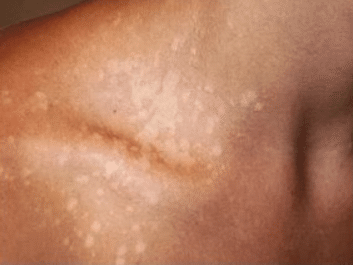
white spots on skin
Milia is the technical term used for small, white bumps that may show up in just about anyone, including infants, and adults. These frustrating yet benign bumps are very stubborn, lasting for weeks, months, sometimes longer.
Though milia aren’t much harmful in any way, getting rid of them can be very tough. There is a right way and a wrong way to get rid of them, and the wrong way might damage the skin.
Unlike acne, milia are rather very firm, and squeezing has very little to no impact on them. Also unlike acne, these bumps may show up around the eyes and on the parts of the face where there aren’t active oil glands. Milia also don’t have the pain that is associated with acne when the pimple forms and then becomes inflamed and also sore.
How to Get Rid of Small White Spots on Skin
- Radish Seeds. It is a known home remedy for the white spots on the skin. Take about 15 grams of the seeds and grind them until they have become coarse powder. Mix the powder with 2tsp of vinegar so as to form a thick paste. Now, use the paste to the white spots and leave for 30 minutes. Rinse off with lukewarm water.
- Turmeric. Take turmeric (10tsp) and mix it with mustard oil (about 250ml) then use it to the spots and then leave the mask for half an hour. Do the process twice daily.
- Cabbage. Take a cabbage and then extract some juice from it then use the juice to the white spots on the skin. Leave it for a few minutes then rinse off with warm water.
- Apple Cider Vinegar. With its acidic nature, the home remedy is also known to destroy the bacteria and fungi that leads to the white patches. Mix some using water and then wash the affected areas with this mixture. This will assist to clean the area keeping it bacteria and fungi free.
- Ginger. Boil hot water and add ginger to it then drink the tea. You might alternatively crush fresh ginger so as to extract its juice then drink the juice. The ginger can assist to increase circulation of blood to the skin.
- Figs. Are very known to have properties that heal the white patches and most small white spots on skin. Consume raw figs for about three months to remove the white patches. This is a perfect way to purify the blood and also aid in its circulation.
- Copper. Pour some water in a copper vessel or flask then leave it throughout the night. In the morning, that water will have infused with the copper ions which aid in the melanin production.
- Honey. It has anti-fungal properties, which assists to kill bacteria found on the skin keeping the skin glowing and also healthy. Honey is also known to absorb in the skin promoting healing.
- Holy Basil. Use some holy basil to the affected areas to remove the patches and white spots. You might alternatively boil some holy basils in water (and add some turmeric if you so wish). Leave the water to cool and once it has reached the room temperature, you might wash the affected skin parts.
- Neem. Take the dried neem leaves, fruits and flowers then crush them to smooth powder and consume a teaspoon with some water every day. This is much beneficial in fighting of the autoimmune disorders hence treating the skin condition.
Further references;
- White Age Spots: http://multiculturalbeauty.about.com/od/Skincare/a/White-Age-Spots.htm
- Vitiligo – Symptoms: http://www.nhs.uk/Conditions/Vitiligo/Pages/Symptoms.aspx
- White Spots on Skin: http://www.md-health.com/White-Spots-On-Skin.html
- White Patches of Skin: Pityriasis Alba: http://www.drgreene.com/qa-articles/white-patches-skin/
- What’s Wrong With My Skin? 38 Causes of Discolored Skin Patches: http://www.healthline.com/health/discolored-skin-patches
- White Spots on Skin: http://www.newhealthguide.org/White-Spots-On-Skin.html
- MILIA: http://cosmeticscop.com/milia/





